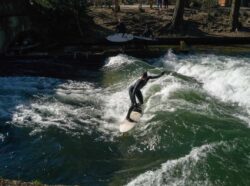Surfing requires as much power as it does fluidity. Whether you’re just starting out or already experienced, your body is constantly under stress: your back during the paddling phase, your shoulders for repeated sessions, and your legs to maintain balance.
Without proper preparation, these demands can lead to pain or injuries. Physiotherapy not only helps correct weaknesses but also optimizes your technique so you can progress faster.
Physical Foundations for Surfing
Back endurance and lumbar extension
Paddling requires spending several minutes—or even hours—in a lumbar extension position, much like a cobra. If your back lacks endurance, discomfort can set in quickly.
In physiotherapy, targeted exercises are often used to strengthen the lower back and improve your tolerance to this posture, helping you paddle longer without pain.
Hip mobility
An effective pop-up relies heavily on your hips. When mobility is limited, your knees or lower back tend to compensate.
An adapted exercise plan can help improve your range of motion, control, and power in transitions.
Leg proprioception
Balancing on a board is a constant challenge. Knee and ankle stability is key, especially in unpredictable waves.
Physiotherapy focuses on balance and dynamic control exercises to strengthen your support and reduce injury risks.
The Most Common Injuries
Lower back pain
This often appears due to prolonged extension or limited hip mobility.
Core endurance and lumbopelvic flexibility training help prevent these issues.
Shoulder tendinopathies
Paddling puts a heavy load on the shoulders. If they lack strength or stability, the risk of rotator cuff tendinopathy increases.
Strengthening stabilizing muscles and gradually adjusting paddling volume are two effective strategies to reduce these injuries.
Knee injuries
Explosive movements and quick twists put knees at risk of ligament or meniscus injuries.
A program focused on stability and neuromuscular control is an effective way to reduce these risks.

How to Prepare for a Surf Trip
On a trip, you often surf much more than at home: several hours a day, sometimes without enough rest. This sudden increase in volume is a frequent cause of injury.
To prepare properly, it’s important to emphasize:
– Shoulder strengthening, to better tolerate paddling
– Back muscle endurance, to support prolonged posture
– Leg stability and proprioception, to absorb more powerful maneuvers
When to See a Physiotherapist?
Certain signs indicate it’s time to book an appointment:
– Recurring back or shoulder pain
– Stiffness that limits movement
– Difficulty handling repeated sessions while traveling
– A history of knee or shoulder injuries
Personalized follow-ups help identify weaknesses, correct mechanics, and build a plan tailored to your practice.
Surfing is demanding, but with the right preparation, you can limit injuries and progress faster. Physiotherapy is a practical tool to strengthen your body, optimize your technique, and fully enjoy your sessions—whether in Montréal or on the other side of the world.

